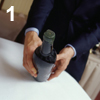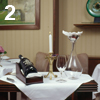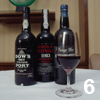Pointers on port
What is port?
Port is a heavy, fortified, red wine from the Douro valley in the north of Portugal. It's made like all other red wines - however, neutral grape spirit (of 77% alcohol) is added, which halts the fermentation process before all the sugar has turned into alcohol, and results in a sweet wine, of between 19 and 20% alcohol.
Grapes such as Touriga Nacional, Touriga Francesca, Tinta Roriz (tempranillo), Tinta Co and Tinta Barroca are picked from sun-baked, steep, terraced vineyards or patamares before being taken to the winery for pressing. Some port houses - such as Taylor's, Fonseca and Croft - still press the best grapes using traditional foot-pressing methods in 6,000-litre stone tanks called lagares.
As a fortified wine it's capable of ageing in wood, or bottle, for a much greater time than other wines, the variety of these ageing methods accounting for the diverse styles of ports available.
Origins of Port Port derives its name from the town of Oporto, which lies at the mouth of the Douro river on the western coast of Portugal. The direct neighbour to Oporto is the town of Villa Nova de Gaia that had traditionally been home to the port lodges - buildings where port is kept to mature for many years after being brought some 400 miles down river from its place of conception.
As a result of 17th-century French and English trade wars, the English began to look to Portugal for wine and gave tax breaks in the early 18th century for the importing of Portuguese wines - thus increasing this trade further. In 1756 Port was the first wine region ever to be given a demarcated area of production by law.
Port regions
The Oporto region divides into three officially recognised sub-regions:
- Baixo (lower) Corgo The most westerly area, producing lighter styles of wines.
- Cima (higher) Corgo Centre of the region, based around the town of Pinho, where most of the major port companies are based.
- Douro Superior Most easterly - hot, inhospitable and arid. It's expensive to produce grapes here.
Styles of port
- White Aperitif-style sweet white port. Delicious served in a tall glass with crushed ice, tonic water, a sprig of fresh mint and a twist of lemon. Commonly known as a "port tonic".
- Ruby Very simple, young and fruity. Can be used in cocktails, mixers or for cooking.
- Tawny A barrel-/cask-aged ruby port. The ageing causes the colour to change from purple to tawny brown.
- Aged tawny Can be aged for 10, 20, 30 or 40 years.
- Colheita This is aged tawny from a single vintage.
- LBV Late bottled vintage. From a single year, bottled four to six years after harvest, which allows the wine to soften and become more approachable. Designed to be in a vintage port style but able to be consumed much earlier because of the late bottling process.
- Single quinta Made from a single estate (quinta), this can be confusing. Single quinta is made the same way as vintage port but comes from grapes originating from only one farm. It can also be made in almost every year, unlike vintage, which is made only in "declared" years.
- Crusted A blend of different years, bottled young and developing like a vintage port.
- Vintage The very best wine, made with the best grapes from a single harvest. Aged for only two years in wood before bottling, these wines develop slowly over a long period (20 to 60 years) and develop heavy sediments or "crusts" that should always be decanted. Only in the best years is a harvest "declared" fine enough to make vintage port. Some of the very best vintages of port are 1997, 1994, 1992, 1985, 1983, 1982, 1980, 1977, 1975, 1970, 1966 and 1963. Usually only vintage and crusted ports will require decanting. Tawny and LBV ports are free from sediment because of the extended time spent in barrel.
Decanting port
You may find some bottles of vintage port without labels. Sometimes there may be a hard wax capsule covering the cork that will have the name of the port house and vintage stamped on it (1). If not, the cork will always bear the name and vintage. Whichever the case, it's important to verify the customer's choice with this information before or after decanting.
Ideally, the bottle should be stood up for 24 hours before decanting to allow sediment to fall, although this is seldom practical in a restaurant. If the bottle has no label, a white paint mark may have been drawn on the bottle. This will indicate what is "up", with the sediment lying opposite. Bring the bottle carefully from the cellar and place in a port cradle or bottle-holder.
Look for signs of seepage around the cork. A sticky, dark residue of expelled port may indicate that it has been stored poorly in an area of fluctuating temperature. The cork has been pushed back and forth by the liquid expanding in a warm environment and contracting in a cool environment. This may have caused slight premature ageing of the port due to oxidation. You should not buy port that shows this symptom, and if it has developed while it has been in your care, consider alternative storage.
Wherever you conduct the decanting process make sure all your mise en place is prepared (2). This will include a clean decanter, candle, possibly a decanting funnel with clean muslin or fine wine mesh, corkscrew, tasting glass, side plate to catch any debris and damp service cloth for wiping the neck of the bottle.
Hard wax capsules may need to chipped away to reveal the head of the cork, which should be done away from customers as it can be messy.
As if lighting a stage for a performance, light the candle on your guridon before you start. This brings the attention of other diners to the decantation and adds to the sense of occasion.
Remove any lead capsule from the neck of the bottle and wipe clean with the cloth. Corks from very old bottles can be quite crumbly, especially at the last half-centimetre where the port has been in contact, so keep your side plate under the neck when extracting the cork to catch any pieces. If any pieces are thought to have fallen inside, use the funnel to strain the port during decanting. Coffee filters or similar fine-grained filters are not recommended as they can take too much flavour from the port.
At this point a small tasting of the port by the sommelier may be necessary. Check for clarity and hue variation (3). Healthy, mature vintage ports should have a wonderfully bright mahogany-tinged rim with a ruby to purple/black centre.
Slowly and steadily pour the port into the decanter using the candle as illumination through the bottle neck to observe the sediment (4).
Some port bottles are made out of very dark impenetrable black glass, designed to protect the port from decades of ageing. In this case, use the funnel as well as the candle. Stop decanting when sediment is observed moving closer to the bottle neck or when deposit is seen in the funnel.
It's possible to open port using port tongs if you feel the cork is too fragile to be removed successfully. The tongs must be heated until red-hot and then clamped around the neck of the bottle below the cork and above the shoulder of the bottle (5) for one to two minutes.
Remove the tongs and apply a small wet towel that has been dipped in iced water to the same area. The rapid change in temperature should cause the neck to crack and break cleanly.
How to match port and food
Port is traditionally consumed as an accompaniment to cheeses, with desserts or as a digestif.
Chilled tawny ports are particularly good with any desserts containing nuts and dried fruits. Apple tarts, pecan pie, almond biscotti, figs and pistachio nuts, caramelised crme brle or fruit cakes are all successful combinations.
Chocolate desserts can be paired with some LBV and young ruby ports.
White port can be served chilled with some hard, crumbly English cheeses such as Cheshire, tawny with hard sheep's cheese and Cheddar. The best and most classic combination is vintage port (6) served with a good quality Stilton. Breads containing raisins or walnuts can be served with these cheeses.
Lighter styles of cigars can be enjoyed with aged tawny ports.
Useful Training Contacts The Academy of Food and Wine Service
James Brown/Sophie Brown
Burgoine House
8 Lower Teddington Road
Kingston, Surrey KT1 4ER
Tel: 020 8943 1011
www.acfws.org
The Court of Master Sommeliers Brian K Julyan, chief executive
Court of Master Sommeliers World-Wide,
1 Seaway Close
Torquay, Devon TQ2 6PY
Tel: 01803 605031
bjulyan@hotmail.com
The Wine and Spirit Education Trust International Wine and Spirit Centre
39-45 Bermondsey Street
London SE1 3XF
Tel: 020 7089 3800
wset@wset.co.uk













